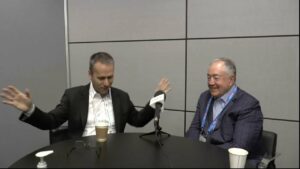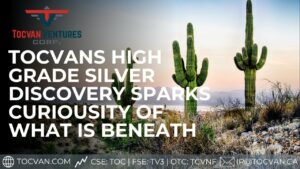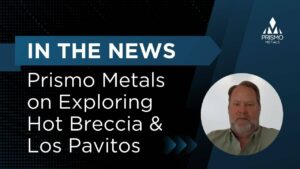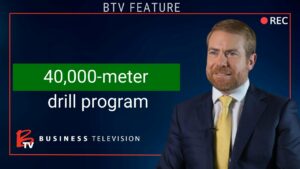TORONTO, April 14, 2021 (GLOBE NEWSWIRE) — Golden Tag Resources Ltd. (“Golden Tag” or the “Company“) (TSX.V: GOG) (OTCQB: GTAGF) is pleased to provide a project update, inclusive of the first three diamond drill holes from the ongoing 4,500 metre (m) exploration program, on the Company’s 100% owned San Diego Project, one of the largest undeveloped silver projects in Mexico.
Key highlights include:
- The current drill campaign has successfully expanded the Fernandez Zone up-dip vertically 40 m toward surface and 20 m to the south. Hole 21-53 intersected 50.17 m grading 104.64 g/t Ag.Eq (from 434.66 m to 484.83 m). The Fernandez Zone remains open above hole 21-53.
- Hole 20-51 encountered 127.3 m of skarn / Fernandez style mineralization within two zones located close to surface, intersecting 35.46 m grading 52.50 g/t Ag.Eq (from 93.20 m to 128.66 m downhole), and 91.84 m grading 49.48 g/t Ag.Eq downhole (from 202.66 m to 294.50 m). These zones are located 365 m above the top of the current Fernandez Zone resource envelope.
- Historical hole 07-24 intersected 50.15 m grading 49.56 g/t Ag.Eq (from 19.80 m to 69.95 m) has been interpreted to be the extension of the Fernandez skarn mineralization encountered in hole 20-51 (collared 5 m to the east of 20-51, drilled 65 m up-dip to the north).
- These broad zones of near surface silver mineralization have been further tested through holes 21-57 and 21-58, with the objective of potentially developing a new zone above the top of the current Fernandez Zone resource.
Greg McKenzie, President and CEO commented: “The first phase of our exploration program has been successful in two meaningful ways. First, expanding the Fernandez Zone mineralized envelope 40 m higher, and 20 m to the south will likely have a positive impact on future resource calculations. The top of the Fernandez Zone remains open, and with the encouraging results from hole 20-51 we followed up with hole 21-58, which was drilled from a different setup. Secondly, the discovery of near surface broad silver mineralization points to the potential for much shallower open pit style mineralization that could be significant catalyst for the San Diego Project. Combined, these results exceeded our expectations and have reinvigorated our excitement in this already substantial silver resource. We look forward to reporting the assays from the remaining five holes in this drill program, and fine tuning our future exploration plans.”
Exploration Program Update
A total of 4,510 m of diamond drilling has been completed in eight holes, including five holes targeting the Trovador & MS Zones (21-52A, 21-53, 21-54, 21-55, 21-56A), two holes targeting the upward extension of the Fernandez Zone (20-51,21-58), and one hole testing the 1849 Zone (21-57) (see Figure 2). The drilling was conducted with oriented core so that the spatial orientation of the mineralization could be determined. Over 3,200 samples have been sent to ALS Geochemistry for analysis, inclusive of 852 samples from infill sampling of holes 11-40 & 11-42 as reported in the Company’s news release dated February 17, 2021. Assay results reported in this news release are from holes 20-51, 21-52A, and 21-53. Holes 21-54 and 21-55 have been logged and samples have been sent in for analysis with assay results pending. Holes 21-56A, 21-57 and 21-58 are in the process of being logged and sampled.
Fernandez Zone Up-Dip Extension
The Fernandez Zone remains an important aspect of the San Diego Project. As outlined in the NI 43-101 Technical Report Mineral Resource Estimate, prepared by SGS Canada Inc. effective April 2013, the Fernandez Zone contains 24.1 million ounces of Ag within the indicated category and 42.4 million ounces of Ag of inferred within a resource envelope that commences 450 m below surface (“surface” established as 1650 m Level) extending down-dip over a vertical depth of 700 m. The current drill campaign has successfully expanded the Fernandez Zone up-dip by 40 m and 20 m to the south, as well as identified new broad zones of silver mineralization located close to surface.
Hole 20-51
This hole was drilled at a steep angle directly over the top of the Fernandez Zone to test the potential upward extension (see Figure 1). Highlighted intercepts are included in Table 1 and demonstrate mineralization from Fernandez extends toward surface. Hole 51 intercepted two separate zones with a combined 127.3 m of mineralization at grades that could potentially exceed the estimated Ag.Eq cutoff grade for open pit mining (25 g/t Ag.Eq).
It is important to recognize previous exploration campaigns on the San Diego Project were focused on high-grade narrow veins and did not evaluate the potential for open pit style of mineralization. Upon review of the prior drill sample database, it was observed that historical hole 07-24 was collared 5 m to the east, drilled 65 m up-dip to the north, intersected 50.15 m @ 49.56 g/t Ag.Eq (from 19.80 m to 69.95 m; 0.05 g/t Au, 33.69 g/t Ag, 0.12% Pb, 0.12% Zn, 0.01 % Cu) which has now been interpreted to be the extension of the Fernandez skarn mineralization encountered in hole 20-51 (from 93.20 m to 128.66 m). As a result of these findings, further follow-up drilling and evaluation of the southern and eastern diorite contact will be pursued.
Table 1 – Select Assay Intervals from Hole 20-51
| Zone | Hole | From | To | Length (m) | Ag.Eq(1) g/t | Au g/t | Ag g/t | Pb % | Zn % | Cu % |
| New | 21-51 | 26.63 | 28.57 | 1.94 | 83.00 | 0.05 | 66.89 | 0.17 | 0.10 | 0.01 |
| Fernandez Extension | 21-51 | 93.20 | 128.66 | 35.46 | 52.50 | 0.06 | 30.27 | 0.14 | 0.24 | 0.01 |
| Fernandez Extension | 21-51 | 202.66 | 294.50 | 91.84 | 49.48 | 0.07 | 15.46 | 0.31 | 0.34 | 0.01 |
| includes | 213.25 | 228.80 | 15.55 | 76.15 | 0.10 | 22.30 | 0.45 | 0.60 | 0.02 | |
| includes | 256.25 | 280.85 | 24.60 | 93.17 | 0.13 | 29.32 | 0.62 | 0.63 | 0.02 | |
| includes | 256.25 | 263.27 | 7.02 | 178.96 | 0.04 | 69.26 | 1.67 | 1.01 | 0.01 | |
| New | 21-51 | 312.92 | 314.07 | 1.15 | 119.50 | 0.08 | 78.53 | 0.40 | 0.39 | 0.02 |
Elements of the Fernandez Zone skarn system were successfully intersected at 93 m (approximately 85 m vertical depth from surface, or 365 m above the previously interpreted top of the Fernandez Zone), returning 35.46 m grading 52.50 g/t Ag.Eq (93.20 m to 128.66 m) in a skarn zone spanning the contact between marble and diorite. A second skarn zone was intersected at 203 m depth in the hole (approximately 190 m vertical depth from surface, or 260 m above the previously interpreted top of the Fernandez Zone) returning 91.84 m grading 49.48 g/t Ag.Eq (202.66 m to 294.50 m) in a skarn zone spanning the contact between diorite and marble. Two zones of endoskarn were encountered within the diorite in this interval: 15.55 m grading 76.15 g/t Ag.Eq (213.25 m to 228.80 m) and 7.02 m grading 178.96 g/t Ag.Eq (256.25 m to 263.27 m). Massive sulphide skarn mineralization was observed to the end of the hole at a depth of 351 m. Unfortunately, due to caving at the top of the hole, 20-51 was terminated at 351 m well before the planned depth of 650 m.
Encouraged by the preliminary results from 20-51, the Company decided to undertake a new hole from a different setup to intersect the planned target and hole 21-58 was completed in March 2021 to a depth of 674 m.
Hole 21-52A
This hole was drilled to test the western side of the Trovador Zone at approximately 225 m from surface and approximately 120 m beneath the previous mine workings (see Figure 1). Three new quartz vein zones were encountered above the Fernandez Zone and to the north of the Trovador Zone: 1.11 m grading 165.43 g/t Ag.Eq (42.22 m to 43.33 m); 3.25 m grading 299.69 g/t Ag.Eq (154.95 m to 158.20 m) including 0.75 m @ 1,160.95 g/t Ag.Eq; 0.50 m grading 332.57 g/t Ag.Eq (160.60 m to 161.10 m). The hole entered the Trovador Structural Zone (TSZ) at 284.70 m and intersected two Trovador Zone veins: 1.44 m grading 102.94 g/t Ag.Eq (286.16 m to 287.60 m) and 1.10 m grading 373.76 g/t Ag.Eq (293.80 m to 294.90 m). Both intersections in the Trovador Zone had higher than usual gold grades: 0.46 g/t Au and 0.28 g/t Au. Unfortunately, from 286 m to the end of the hole at 350 m, core recovery was only 86% within areas of mineralization due to open spaces and possible oxide zone soil-like material and it is possible that mineralized veins that typically form part of the TSZ were not recovered, sampled, and assayed.
Hole 21-53
Elements of the Fernandez Zone skarn system were intersected at 298 m depth in the hole (approximately 275 m vertical depth from surface or 175 m above the previously interpreted top of the Fernandez Zone) to a depth of 559.5 m (approximately 500 m vertical depth from surface) where the hole crossed into the TSZ (see Figures 3 and 4). The TSZ is distinguished by the development of an alteration zone of bleached intensely silicified limestones and dark marble with fluid escape structures with open-space filling quartz veins associated with cataclastite and mylonite zones, whereas the Fernandez Zone is distinguished by skarn alteration (epidote-chlorite-pyroxene-magnetite-garnet) in diorite and limestones which have been recrystallized to marble.
A total of 11 zones with quartz-sulphide and stockwork veining with associated skarn alteration were intersected from 298 m to 559.5 m. Two zones in particular stand out: 1) A zone of exoskarn which returned 8.41 m grading 73.86 g/t Ag.Eq (349.07 m to 357.48 m; approximately 330 m vertical depth from surface or 120 m above the interpreted top of the Fernandez Zone). 2) A zone of exoskarn with quartz-sulphide stockwork veins, disseminated sulphides and massive sulphide bands characteristic of the Fernandez Zone returning 50.17 m grading 104.64 g/t Ag.Eq (434.66 m to 484.83 m; approximately 400 m vertical depth from surface). Hole 21-53 successfully extends the Fernandez Zone approximately 40 m upwards vertically toward the surface, and 20 m to the south of the currently defined resource envelope. Furthermore, there are another three zones of exoskarn mineralization which lie between the Fernandez Zone envelope and the Trovador Zone: 2.15 m grading 115.29 g/t Ag.Eq, and 4.48 m grading 67.82 g/t Ag.Eq, 4.95 m grading 115.61 g/t Ag.Eq. The hole then progressed into the TSZ intersecting three Trovador Zone veins: 1.66 m grading 135.65 g/t Ag.Eq (563.00 m to 564.66 m), 0.90 m grading 330.44 g/t Ag.Eq (596.28 m to 597.18 m), 0.49 m grading 235.17 g/t Ag.Eq (600.40 m to 600.89 m). This was followed by two veins intersected in the MS Zone: 1.80m grading 107.87 g/t Ag.Eq (624.45 m to 626.25 m), 0.61 m grading 260.51 g/t Ag.Eq (629.77 m to 630.38 m). Five new veins were discovered further to the south of the MS Zone: 0.52 m grading 351.00 g/t Ag.Eq (639.53 m to 640.05 m), 1.63 m grading 184.39 g/t Ag.Eq (655.47 m to 657.10 m), 0.91 m grading 158.01 g/t Ag.Eq (677.70 m to 678.61 m), 0.51 m grading 149.40 g/t Ag.Eq (762.86 m to 763.37 m), 0.48 m grading 147.03 g/t Ag.Eq (768.83 m to 769.31 m). The TSZ veins generally contain higher copper and gold grades than that seen in other zones on the property.
Table 2 – Select Assay Intervals from Holes 21-52 & 53
| Zone | Hole | From | To | Length (m) | Ag.Eq(1) g/t | Au g/t | Ag g/t | Pb % | Zn % | Cu % |
| New | 21-52A | 42.22 | 43.33 | 1.11 | 165.43 | 0.09 | 142.00 | 0.13 | 0.21 | 0.02 |
| New | 21-52A | 154.95 | 158.20 | 3.25 | 299.69 | 0.02 | 237.02 | 0.41 | 0.82 | 0.08 |
| includes | 154.95 | 155.70 | 0.75 | 1,160.95 | 0.03 | 953.20 | 1.41 | 2.64 | 0.30 | |
| New | 21-52A | 160.60 | 161.10 | 0.50 | 332.57 | 0.02 | 248.00 | 0.52 | 1.28 | 0.05 |
| Trovador | 21-52A | 286.16 | 287.60 | 1.44 | 102.94 | 0.46 | 47.82 | 0.07 | 0.16 | 0.05 |
| Trovador | 21-52A | 293.80 | 294.90 | 1.10 | 373.76 | 0.28 | 194.80 | 1.70 | 1.92 | 0.07 |
| New | 21-53 | 115.80 | 118.90 | 3.10 | 126.60 | 0.14 | 85.63 | 0.41 | 0.27 | 0.02 |
| New | 21-53 | 127.86 | 130.55 | 2.69 | 390.85 | 0.05 | 354.91 | 0.30 | 0.41 | 0.02 |
| New | 21-53 | 159.58 | 160.23 | 0.65 | 726.01 | 0.08 | 684.00 | 0.40 | 0.34 | 0.06 |
| New | 21-53 | 182.90 | 183.50 | 0.60 | 209.27 | 0.05 | 162.00 | 0.68 | 0.37 | 0.02 |
| New | 21-53 | 299.26 | 301.35 | 2.09 | 325.93 | 0.18 | 132.71 | 1.42 | 2.60 | 0.08 |
| New | 21-53 | 305.45 | 306.85 | 1.40 | 131.40 | 0.06 | 42.64 | 0.91 | 1.05 | 0.03 |
| New | 21-53 | 319.28 | 319.80 | 0.52 | 771.66 | 0.20 | 263.00 | 6.94 | 5.08 | 0.14 |
| New | 21-53 | 342.20 | 342.70 | 0.50 | 212.38 | 0.02 | 71.20 | 1.53 | 1.68 | 0.08 |
| New | 21-53 | 349.07 | 357.48 | 8.41 | 73.86 | 0.02 | 24.55 | 0.61 | 0.49 | 0.03 |
| New | 21-53 | 364.90 | 365.89 | 0.99 | 122.14 | 0.07 | 26.30 | 0.77 | 1.25 | 0.05 |
| New | 21-53 | 421.16 | 424.98 | 3.82 | 90.40 | 0.04 | 28.16 | 0.76 | 0.60 | 0.04 |
| Fernandez Extension | 21-53 | 434.66 | 484.83 | 50.17 | 104.64 | 0.05 | 31.52 | 0.91 | 0.68 | 0.06 |
| New | 21-53 | 495.47 | 497.62 | 2.15 | 115.29 | 0.02 | 36.72 | 0.86 | 0.93 | 0.04 |
| New | 21-53 | 505.22 | 509.70 | 4.48 | 67.82 | 0.04 | 20.66 | 0.58 | 0.48 | 0.02 |
| New | 21-53 | 528.46 | 533.41 | 4.95 | 115.61 | 0.08 | 40.29 | 0.97 | 0.65 | 0.04 |
| Trovador | 21-53 | 563.00 | 564.66 | 1.66 | 135.65 | 0.93 | 17.66 | 0.49 | 0.40 | 0.03 |
| Trovador | 21-53 | 596.28 | 597.18 | 0.90 | 330.44 | 0.06 | 119.20 | 1.69 | 2.92 | 0.10 |
| Trovador | 21-53 | 600.40 | 600.89 | 0.49 | 235.17 | 0.03 | 125.00 | 0.63 | 1.62 | 0.10 |
| MS | 21-53 | 624.45 | 626.25 | 1.80 | 107.87 | 0.06 | 30.50 | 0.62 | 0.99 | 0.04 |
| MS | 21-53 | 629.77 | 630.38 | 0.61 | 260.51 | 0.17 | 28.90 | 0.78 | 3.90 | 0.09 |
| New | 21-53 | 639.53 | 640.05 | 0.52 | 351.00 | 0.01 | 130.00 | 3.17 | 2.18 | 0.08 |
| New | 21-53 | 655.47 | 657.10 | 1.63 | 184.39 | 0.02 | 86.24 | 0.27 | 1.66 | 0.09 |
| New | 21-53 | 677.70 | 678.61 | 0.91 | 158.01 | 0.10 | 66.54 | 0.75 | 1.15 | 0.03 |
| New | 21-53 | 762.86 | 763.37 | 0.51 | 149.40 | 0.64 | 31.80 | 0.91 | 0.64 | 0.02 |
| New | 21-53 | 768.83 | 769.31 | 0.48 | 147.03 | 0.11 | 70.60 | 0.97 | 0.67 | 0.02 |
(1) All results in this release are rounded. Assays are uncut and undiluted. Widths are core-lengths, not true widths as a full interpretation of actual orientation of mineralization is not complete. Intervals of skarn, massive sulphide or stockwork quartz-sulphide vein mineralization to a vertical depth of 300 m were chosen based on a 25 g/t Ag.Eq cutoff with no more than 9 m of dilution and below 300 m were chosen based on a 53 g/t Ag.EQ cutoff with no more than 4 m of dilution. Silver equivalent: Ag.Eq g/t was calculated using 3-year trailing average commodity prices of $17.75/oz Ag, $0.90/lb Pb, $1.20/lb Zn, $1500/oz Au, and $2.85/lb Cu. The calculations assume 100% metallurgical recovery and are indicative of gross in-situ metal value, the Company is planning to perform additional metallurgical studies later in 2021.
Sample Analysis and QA/QC Program
Golden Tag Resources uses a quality assurance/quality control (QA/QC) program that monitors the chain of custody of samples and includes the insertion of blanks, duplicates, and reference standards in each batch of samples sent for analysis. Drill core is photographed, logged, and cut in half with one half retained in a secured location for verification purposes and one half shipped for analysis. Sample preparation (crushing and pulverizing) is performed at ALS Geochemistry, an independent ISO 9001:2001 certified laboratory, in Zacatecas, Mexico and pulps are sent to ALS Geochemistry in Vancouver, Canada and Lima, Peru for analyses. The entire sample is crushed to 70% passing -2 mm and a riffle split of 250 grams is taken and pulverized to better than 85% passing 75 microns. Samples are analyzed for gold using a standard fire assay with Atomic Absorption Spectrometry (AAS) (Au-AA23) from a 30-gram pulp. Gold assays greater than 10 g/t are re-analyzed on a 30-gram pulp by fire assay with a gravimetric finish (Au-GRA21). Samples are also analyzed using a 35 element inductively coupled plasma (ICP) method with atomic emission spectroscopy (AES) on a pulp digested by aqua regia (ME-ICP41). Overlimit sample values for silver (>100 g/t), lead (>1%), zinc (>1%), and copper (>1%) are re-assayed using a four-acid digestion overlimit method with ICP-AES (ME-OG62). For silver values greater than 1,500 g/t samples are re-assayed using a fire assay with gravimetric finish on a 30-gram pulp (Ag-GRA21). No QA/QC issues were noted with the results reported herein.
True widths of drill intercepts have not been determined. Assays are uncut except where indicated.
Review by Qualified Person and QA/QC
The scientific and technical information in this document has been reviewed and approved by Bruce Robbins, P.Geo., a Qualified Person as defined by National Instrument 43-101.
About Golden Tag Resources
Golden Tag Resources Ltd. is a Toronto based mineral resource exploration company. The Company holds a 100% interest, subject to a 2% NSR, in the San Diego Project, in Durango, Mexico. The San Diego property is among the largest undeveloped silver assets in Mexico and is located within the prolific Velardeña Mining District. Velardeña hosts several mines having produced silver, zinc, lead and gold for over 100 years. For more information regarding the San Diego property please visit our website at www.goldentag.ca.
For additional information, please contact:
Greg McKenzie, President & CEO
Ph: 416-504-2020
Email: [email protected]
www.goldentag.ca
Cautionary Statement:
Neither the TSXV nor its Regulation Services Provider (as that term is defined in the policies of the TSXV) accepts responsibility for the adequacy or accuracy of this news release. Certain statements in this news release are forward-looking and involve a number of risks and uncertainties. Such forward-looking statements are within the meaning of the phrase ‘forward-looking information’ in the Canadian Securities Administrators’ National Instrument 51-102 – Continuous Disclosure Obligations. Forward-looking statements are not comprised of historical facts. Forward-looking statements include estimates and statements that describe the Company’s future plans, objectives or goals, including words to the effect that the Company or management expects a stated condition or result to occur. Forward-looking statements may be identified by such terms as “believes”, “anticipates”, “expects”, “estimates”, “may”, “could”, “would”, “will”, or “plan”. Since forward-looking statements are based on assumptions and address future events and conditions, by their very nature they involve inherent risks and uncertainties. Although these statements are based on information currently available to the Company, the Company provides no assurance that actual results will meet management’s expectations. Risks, uncertainties and other factors involved with forward-looking information could cause actual events, results, performance, prospects and opportunities to differ materially from those expressed or implied by such forward-looking information. Forward-looking information in this news release includes, but is not limited to, statements regarding the effects of the Company’s exploration program, assay results from the ongoing drill program, the expansion of the Fernandez Zone or the Trovador Structural Zone, ability to define open pit style resources, further improvements in mineralization, continuity or grades. Factors that could cause actual results to differ materially from such forward-looking information include, but are not limited to: the ability to predict and counteract the effects of COVID-19 on the business of the Company, including but not limited to the effects of COVID-19 on the price of commodities, capital market conditions, restriction on labour and international travel and supply chains; failure to identify mineral resources; failure to convert estimated mineral resources to reserves; the inability to complete a feasibility study which recommends a production decision; the preliminary nature of metallurgical test results; delays in obtaining or failures to obtain required governmental, environmental or other project approvals; political risks; changes in equity markets; uncertainties relating to the availability and costs of financing needed in the future; the inability of the Company to budget and manage its liquidity in light of the failure to obtain additional financing; inflation; changes in exchange rates; fluctuations in commodity prices; delays in the development of projects; capital, operating and reclamation costs varying significantly from estimates and the other risks involved in the mineral exploration and development industry; and those risks set out in the Company’s public documents filed on SEDAR. Although the Company believes that the assumptions and factors used in preparing the forward-looking information in this news release are reasonable, undue reliance should not be placed on such information, which only applies as of the date of this news release, and no assurance can be given that such events will occur in the disclosed time frames or at all. The Company disclaims any intention or obligation to update or revise any forward-looking information, whether as a result of new information, future events or otherwise, other than as required by law. No stock exchange, securities commission or other regulatory authority has approved or disapproved the information contained herein.




























